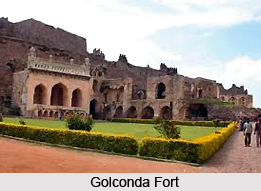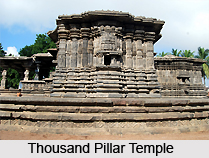 Archaeological Sites in Telangana deals with the ancient and medieval monuments and relics built during the time of Chalukyas, Rashtrakutas, and Cholas and Kakatiya Dynastical regime. Later the Mughal and the Qutub Sahi Dynasty rose into power that added more archaeological sites, which are now tourist"s attractions.
Archaeological Sites in Telangana deals with the ancient and medieval monuments and relics built during the time of Chalukyas, Rashtrakutas, and Cholas and Kakatiya Dynastical regime. Later the Mughal and the Qutub Sahi Dynasty rose into power that added more archaeological sites, which are now tourist"s attractions.
Golconda
Golconda which is also known as Golkonda or Golla konda means the shepherd`s hill. Golconda is famous for its medieval fort and diamonds. Golconda is now a ruined fort of Southern India and capital of medieval Golconda Sultanate (1518-1687). Golconda Fort is situated 11 km west of Hyderabad. Golconda is also a mandal of Hyderabad District of Telangana. The region is universally famous for the mines that have produced the world`s most famous and coveted gems, including the Hope Diamond, The Eye of the Idol, which is also known as the Nassak Diamond.
Golconda Fort
Golconda fort was first built by the rulers of Kakatiya times as part of their western defences. Golconda fort was built in the first half of the medieval times 945 -970 AD on the lines of the Kondapalli fort. The city and fortress are built on a granite hill that is 120 meters, which is about 400 ft high. Golconda fort is surrounded by massive crenulated ramparts. The fort was rebuilt and strengthened by Pratapa Rudra of Kakatiya dynasty. The fort was further strengthened by Musunuri Nayaks who overthrew the Tughlak army occupying Warangal city. The fort was ceded by the Musunuri chief, Kapaya Nayaka to the Bahmanis Dynasty as part of the treaty in 1364 AD. The fort became the capital of a major province in the Sultanate and after it collapsed the capital of the Qutb Shahi kings. The fort finally fell into ruins after a siege and its fall to Mughal emperor Aurangazeb in 1687 AD.
Kakatiya Kala Thoranam
Kakatiya Kala Thoranam is a historical arch and symbol of Kakatiya Dynasty in Telangana and Andhra Pradesh. It is also called Warangal gate as it is located in Warangal district of Telangana. It was also included as the main symbol in the Emblem of Telangana for the state of Telangana, a newly formed state in India with Hyderabad as its capital. Kakatiya dynasty in early medieval era was a South Indian dynasty that ruled most of the Telugu speaking lands covered by Telangana and Andhra Pradesh from 1083 to 1323 AD with Orugallu, now Warangal, as its capital. The Shaivite Hindu in kingdom, was one of the great Telugu empires that lasted for centuries until the conquest by the Delhi Sultanate.
Thousand Pillar Temple
 Thousand Pillar Temple is a historic ancient Hindu temple located in the town of Hanamakonda of Telangana State. Thousand Pillar Temple is dedicated to Lord Shiva or Mahadeva, Lord Vishnu and Lord Surya. Thousand Pillar Temple is one of the very old temples of South India that was built by the glorious Kakatiya rulers. It stands out to be a masterpiece and achieved major heights in terms of architectural skills by the ancient Kakathiya Vishwakarma Sthapathis. It is believed that the Thousand Pillar Temple was built by King Rudra Deva in 1163 AD. Thousand Pillar Temple is a specimen of the Kakatiyan style of architecture of the 12th century AD. Thousand Pillar Temple was destroyed by the Tughlaq dynasty during their invasion of South India. It consists of one temple and other building. There are one thousand pillars in the building and the temple, but no pillar obstructs a person in any point of the temple to see the God in the other temple. The present day engineers have taken out all the pillars from the building. After they lifted all the pillars they encountered a huge mass of sand. It took nearly two weeks for them to take away all the sand. It was wet sand, because of a pipe connection from the nearby water body named Bhadrakali Cheruvu.
Thousand Pillar Temple is a historic ancient Hindu temple located in the town of Hanamakonda of Telangana State. Thousand Pillar Temple is dedicated to Lord Shiva or Mahadeva, Lord Vishnu and Lord Surya. Thousand Pillar Temple is one of the very old temples of South India that was built by the glorious Kakatiya rulers. It stands out to be a masterpiece and achieved major heights in terms of architectural skills by the ancient Kakathiya Vishwakarma Sthapathis. It is believed that the Thousand Pillar Temple was built by King Rudra Deva in 1163 AD. Thousand Pillar Temple is a specimen of the Kakatiyan style of architecture of the 12th century AD. Thousand Pillar Temple was destroyed by the Tughlaq dynasty during their invasion of South India. It consists of one temple and other building. There are one thousand pillars in the building and the temple, but no pillar obstructs a person in any point of the temple to see the God in the other temple. The present day engineers have taken out all the pillars from the building. After they lifted all the pillars they encountered a huge mass of sand. It took nearly two weeks for them to take away all the sand. It was wet sand, because of a pipe connection from the nearby water body named Bhadrakali Cheruvu.
Warangal
Warangal which was also known as Orugallu and Ekasila Nagaram is an ancient city and district headquarters of Warangal district in Indian state of Telangana. Warangal is located 148 kilometres northeast of the state capital of Hyderabad and is the administrative headquarters of Warangal District. Warangal area is a combination of Warangal, Hanmakonda and Kazipet. Warangal is the second biggest city next to Hyderabad in Telangana. Warangal was the capital of Kakatiya kingdom ruled by the Kakatiya dynasty from the 12th to the 14th centuries. The Kakatiyas left many monuments, including an impressive fortress, four massive stone gateways, the Swayambhu temple dedicated to Lord Shiva, and the Ramappa temple situated near Ramappa Lake.
Phanigiri
Phanigiri in Telangana is a Buddhist monastic complex. It is also known as Buddha Vihara. Phanigiri lies at about 125 kilometers from Hyderabad, which is now the capital of Telangana and Andhra Pradesh for 10 years. Phanigiri, an archaeological site in Telangana is located near the National Highway No. 9. Phanigiri is measured as a Buddhist site as great as the Nagarjunakonda and Amaravathi, which are now the property of State Department of Archaeology and Museums.



















